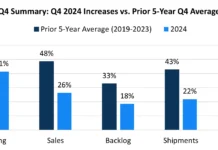by Chris Kuehl, managing director
Armada Corporate Intelligence
 As readers must be aware, it is the job of the economist to point out the dark cloud that accompanies every silver lining. No good deed goes unpunished, and they don’t call us dismal scientists for nothing. Now that I have set the tone, we can discuss the impact of the tax cut and what the various phases will look like through the year and beyond. We can start with the good news.
As readers must be aware, it is the job of the economist to point out the dark cloud that accompanies every silver lining. No good deed goes unpunished, and they don’t call us dismal scientists for nothing. Now that I have set the tone, we can discuss the impact of the tax cut and what the various phases will look like through the year and beyond. We can start with the good news.
The Good
The tax cut has definitely stimulated the economy in a variety of ways. Consumers have more money to spend, as many saw their tax burden reduced and many also happened to work for companies that chose to share their tax reduction through bonuses and pay hikes. Businesses saw a reduction in their taxes as well – generally reducing rates from around 37 percent to around 25 percent. Some of the tax breaks that certain businesses had relied on have been eliminated – but not all that many. This leaves a lot more in the corporate coffers than before, and the money will be directed in a variety of ways – some more productive than others. There will be investment in new equipment, and there will be hiring (provided people can be found who are worth hiring). There also will be bigger payouts to owners and investors and money sunk into stock buyback, investments and purchases in foreign markets. These latter options are not as useful for the economy as a whole.
It is true that a stimulative tax cut like this would have been more effective when the economy was moribund, but there will be reasons to celebrate the windfall for the first half of the year in any case.
The Bad
The timing of the tax cuts is what creates the bad scenario. The economy already was growing at a nice pace before the cuts, and now it is adding gasoline to a fire that already exists. This rapid influx of corporate and consumer cash can overheat an economy quickly.
Here is how a tax cut fuels inflation. The business community decides to use this money to expand. They start to buy machines, hire people and use more of the inputs they depend on – fuel, metals and the like. This new demand for these products is coming at a time when most suppliers have been ratcheting down output, and now they will struggle to keep pace with that demand and, almost inevitably, the price of all these inputs, machines and workers will rise. The faster the growth, the more urgency there is not to be left behind and that pushes those prices even higher.
Consumers play their part as well. They have money, and they will spend it. Right now, the savings rate for the US consumer is as low as it was at the start of the recession, and people are no longer reluctant to haul out their plastic. As they create demand, the producers have a reason to hike prices and the consumer starts to feel an inflationary pang. This propels them to spend even more – and faster – as they fear that the things they want will be even more expensive in the future. The natural reaction to inflation by a consumer is exactly the opposite of what would be preferred for the economy as a whole, but it happens every time.
So, now we have inflation. What is so bad about that? In the first place, it makes everything more expensive and creates a cycle that is hard to end. The person seeing higher prices for their basic needs and wants will try to get paid more, and the company that has to pay more will raise prices to cover these costs, and then people will want to be paid more so they can afford the price hikes.
Beyond that, inflation is the scourge of the financial community, and banks get very cautious. They do not want to lend money that inflation will rob of its value in the future, so access to capital is suddenly restricted. The big attitude change will be at the Federal Reserve as they will swing into action to blunt that inflation surge. Interest rates will climb quickly and consistently in an effort to shut off the advancing threat of inflation. We have been living through an extraordinarily long period of loose monetary policy as the Fed has been pulling out all the stops to goose the economy forward. That ends and is replaced by an equally aggressive attempt to slow things down. This shift in strategy could start as soon as the middle part of the year, as it often takes several months for a restrictive Fed policy to start working – especially if the economy is flush with cash. Much of the gain made at the start of the year could be lost at the end of the year if these rates ratchet up far and fast enough.
The Ugly
This brings us to the ugly part. These tax cuts are going to balloon an already inflated deficit and debt. Somewhere along the way, the fiscal hawks all seem to have migrated elsewhere, and even the GOP seems more than cavalier about the threat of debt. The estimates hold that these tax cuts will add another $1.5 trillion to the debt and deficit and both of these are already far too high for any sense of fiscal comfort. Our national debt is close to 104 percent of the national GDP and, bear in mind, the US GDP is the largest in the world at just over $19 trillion. China is second, with a GDP of just over $12 trillion. We have states that have GDP numbers as large as major countries (France has a GDP roughly the size of Californias, and Texas compares to Canada). Adding to the debt burden is not a good thing and neither is adding to the deficit, which now is sitting at over three percent of the national GDP. This is considered well past acceptable levels.
In order for the US to handle these debt burdens now, annual growth of between five and seven percent will be required – and the US simply doesn’t grow that fast. We are getting very excited about three percent growth and are not sure we can even maintain that pace. If we can’t grow fast enough to reduce the burdens, there are not very palatable alternatives, such as massive budget cuts and significant increases in revenue. Given that there was just a big tax cut, the likelihood of revenue enhancement is nil. That leaves those big cuts and that means taking a knife to the biggest US budget items. These are Social Security, Medicaid, Medicare and the Defense Department. Dont hold your breath on changing any of these.
What happens if there are no cuts, no hike in revenues and not enough growth? We will keep doing what we have been doing for the last decade or longer. We will borrow more and more to be able to make the budget, which makes the problem larger later. This is the fundamental issue with economics as ruled by political expedience. As long as the crisis occurs on the next leader’s watch, it is all just fine.
What should the US be doing right now? The growth that we have experienced should be channeled into reducing our obligations and setting us up to handle future issues. Any businessman will tell you that having a rainy-day fund is crucial and that spending every dime from a good quarter or year is the height of folly. Consumers even know to save, but that message always seems to be lost on those that ostensibly lead.
Chris Kuehl is managing director of Armada Corporate Intelligence. Founded by Keith Prather and Chris Kuehl in January 2001, Armada began as a competitive intelligence firm, grounded in the discipline of gathering, analyzing and disseminating intelligence. Today, Armada executives function as trusted strategic advisers to business executives, merging fundamental roots in corporate intelligence gathering, economic forecasting and strategy development. Armada focuses on the market forces bearing down on organizations. For more information, visit www.armada-intel.com.




